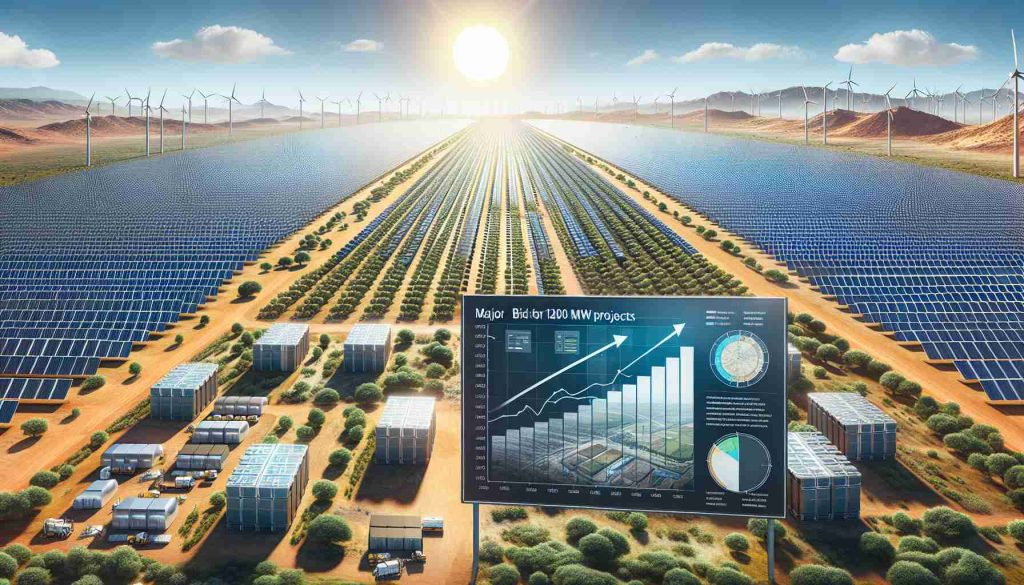India Seeks Growth in Solar Energy with Major Bid for 1200 MW Projects and Storage Integration – yTech
Summary: The Solar Energy Corporation of India (SECI) has unveiled a significant step in accelerating India’s transition to clean energy. By calling for tenders on large-scale solar power projects comprising 1200 MW with an integrated 600 MWh of Energy Storage Systems (ESS), SECI is aiming to fortify the country’s renewable energy infrastructure and meet ambitious goals.
India’s quest for sustainable energy is gaining momentum with the latest announcement from SECI. Through a new tender initiative, the corporation is seeking proposals for the creation of 1200 MW of solar power infrastructure, integrated with energy storage capabilities to enhance grid consistency. This strategic move looks to address the challenges of solar energy’s variable nature, promoting a more reliable energy solution for the country.
SECI’s integration of energy storage in the solar projects is an insightful approach to mitigate the unpredictability of solar power production, thereby enabling continuous energy supply. This is essential for pathing the way toward a fully renewable grid that can withstand the demands of the nation’s power consumption.
By aligning this initiative with India’s target of attaining 450 GW of renewable energy by 2030, a vision strongly advocated by Prime Minister Narendra Modi, SECI is playing a central role in the nation’s renewable energy advancements. These efforts are key to diminishing the reliance on fossil fuels and curbing greenhouse gas emissions.
Industry participants answering SECI’s call for bids will be instrumental in the renewable sector’s expansion. The fruition of these solar projects with integrated ESS is anticipated not only to propel India towards its environmental goals but also to stimulate innovation within the solar technology field. This evolution represents a pivotal aspect of India’s journey to a more sustainable and forward-looking energy paradigm.
India’s Solar Energy Market Growth and Forecast
India’s solar energy market has been expanding rapidly. With increasing investments and government support, the industry is witnessing a considerable growth trajectory. According to market research, the Indian solar power sector is expected to continue growing at a significant pace. Forecasts suggest that the addition of large-scale solar projects, such as the ones tendered by SECI, will further drive this growth. Given India’s ambitious goal of reaching 450 GW of renewable energy capacity by 2030, the market for solar installations—both photovoltaic (PV) systems and concentrated solar power (CSP) plants—is expected to expand significantly.
The government’s push for renewables has also led to a substantial decrease in solar power costs, making it increasingly competitive with conventional energy sources. With projects that integrate energy storage systems, like the one initiated by SECI, the market is not only geared for growth in terms of capacity but also in ensuring reliable energy supply and addressing intermittency issues associated with solar energy.
Key Issues and Challenges in the Solar Industry
The integration of large-scale solar power with energy storage systems presents its own set of unique challenges. Energy storage technology, while advancing, remains costly and is often cited as a limiting factor in the adoption of renewable energy at larger scales. Moreover, managing the supply chain for the manufacturing and deployment of solar panels and ESS can be complex, facing potential shortages in raw materials or disruptions from global trade tensions.
There is also the matter of grid integration. As the penetration of solar power in India’s energy mix increases, the electricity grid must be up-scaled and modernized to handle the variability and distributed nature of renewable energy sources. This includes developments in smart grid technology and improving grid infrastructure to maintain stability and avoid blackouts.
Despite these challenges, the solar industry continues to innovate, developing more efficient solar panels, designing better battery storage technologies, and implementing more sophisticated grid management systems to accommodate the growing share of renewable energy.
Conclusion
The initiative by SECI to incorporate energy storage into its latest solar power project is an important step towards a more sustainable energy future for India. It supports the industry’s progression by fostering technological innovation and resolving issues of variability and grid integration. If successful, this project could serve as a blueprint for other nations looking to enhance their own renewable energy infrastructures.
For further information on industry developments and market forecasts, you can visit related authoritative sources like the International Solar Alliance at International Solar Alliance or the International Energy Agency at International Energy Agency, both of which provide global insights and data on the solar power industry.
[embedded content]

Leokadia Głogulska is an emerging figure in the field of environmental technology, known for her groundbreaking work in developing sustainable urban infrastructure solutions. Her research focuses on integrating green technologies in urban planning, aiming to reduce environmental impact while enhancing livability in cities. Głogulska’s innovative approaches to renewable energy usage, waste management, and eco-friendly transportation systems have garnered attention for their practicality and effectiveness. Her contributions are increasingly influential in shaping policies and practices towards more sustainable and resilient urban environments.
This post was originally published on 3rd party site mentioned in the title of this site


